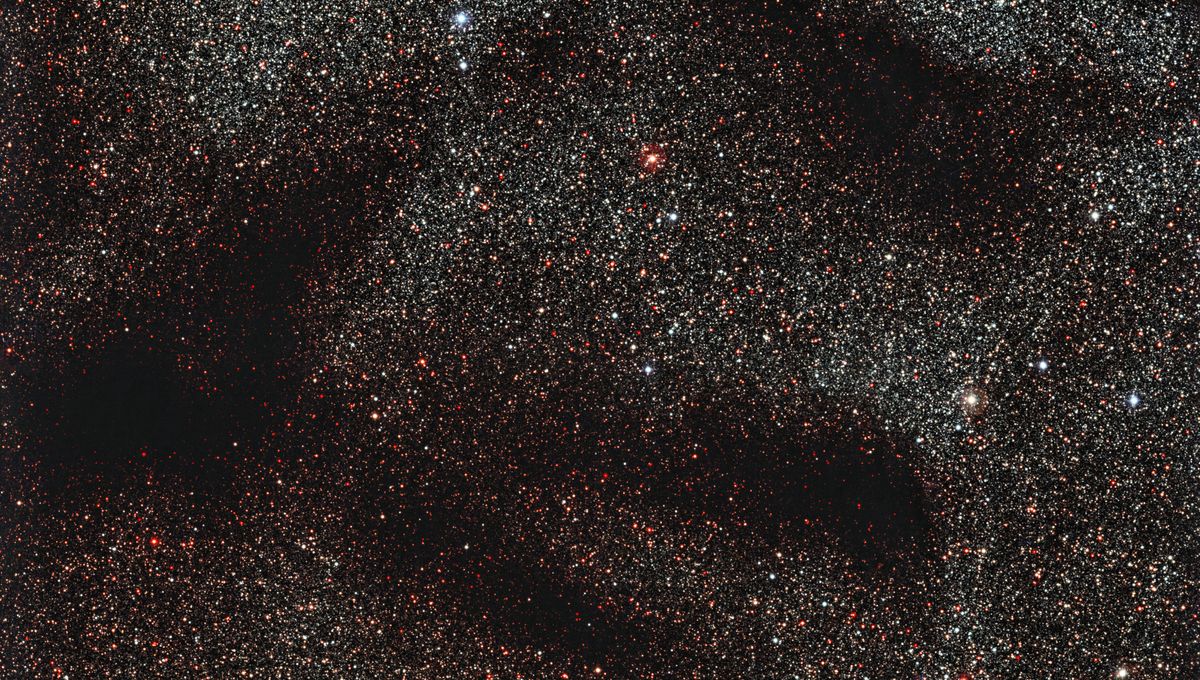
One of the largest structures in the sky, as seen from our perspective, has only just been discovered. It’s an enormous cloud of molecular hydrogen gas that may one day condense down into stars. However, because its light is only detectable in a rarely studied part of the spectrum, all this gas has not been seen until now.
The Big Bang left a lot of hydrogen behind. Where clouds were thickest, gravity slowly increased that concentration, leading to the formation of stars, which in their deaths seeded more diffuse clouds with other elements. Today, most of the Milky Way’s primordial gas has already become stars, or is dispersed in the galactic halo at densities far too low for star formation.
Much of the material in neither category lies in star-forming regions like the Orion Nebula, previously thought to be the nearest molecular cloud to us, where the first stars to form are lighting up the remaining gas. Astronomers have now discovered there is a much closer cloud, which they’ve named Eos. Eos is much denser than the galactic halo, but considerably less so than the Orion Nebula, so while it may eventually form stars, that day is far off. The name refers to the Greek goddess of the dawn, but it might be more accurate to compare Eos to the pre-dawn darkness.
What Eos lacks in density, it more than makes up for in size. It’s up to 80 light-years across, and contains between 2,000 and 8,500 solar masses, depending on the methods used to estimate it, of which just 44 solar masses is dust. At 300 light-years away, at the edge of the local bubble, it’s far closer than any star-forming region and, by galactic standards, this is our neighborhood. For example, that makes it closer than such famous stars as Betelgeuse or Antares. Its crescent shape takes up 25 degrees of the sky, exceeded only by the Milky Way in angular dimensions among structures we have detected.
Molecular hydrogen is not easy to find if there are no stars nearby to heat it up. Since hydrogen clouds are usually accompanied by dust or a smattering of other gases, most previous detections have been made using radio waves of infrared radiation, revealing the presence of carbon monoxide.
However, even with no nearby stars, Eos is releasing some radiation in the far ultraviolet – a portion of the spectrum that has previously been hard to capture – around the edges, where the gas has become heated.
That heat raises the possibility that instead of forming stars of its own, Eos will be evaporated by radiation from surrounding stars. The team thinks it probable the gas will be spread across the galaxy within 6 million years, rather than collapsing into stars, but admit competing forces make it a close-run thing.
“This is the first-ever molecular cloud discovered by looking for far ultraviolet emission of molecular hydrogen directly,” Dr Blakesley Burkhart of Rutgers University said in a statement. “The data showed glowing hydrogen molecules detected via fluorescence in the far ultraviolet. This cloud is literally glowing in the dark.”
The observations were made using a spectrograph specifically tailored to this part of the spectrum on the Korean satellite STSAT-1. The data from STSAT-1’s survey of 70 percent of the sky was released in 2023, and Burkhart was the first to notice evidence of Eos. Because Eos is very light for dust or carbon monoxide, previous sky surveys had missed it.
“This opens up new possibilities for studying the molecular universe,” Burkhard added.
“When I was in graduate school, we were told that you can’t easily directly observe molecular hydrogen,” Dr Thavisha Dharmawardena of New York University said. “It’s kind of wild that we can see this cloud in data that we didn’t think we would see.”
“The use of the far ultraviolet fluorescence emission technique could rewrite our understanding of the interstellar medium, uncovering hidden clouds across the galaxy and even out to the furthest detectable limits of cosmic dawn,” Dharmawardena added.
Burkhart is also the author of a paper under peer review reporting the most distant molecular hydrogen ever seen, found using the JWST, and has hopes for a more comprehensive search of the sky for molecular hydrogen.
Eos’ discovery is reported in Nature Astronomy.
Source Link: There’s An Enormous "Glow In The Dark" Cloud Of Gas We Never Noticed Remarkably Close To Earth